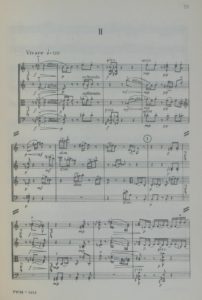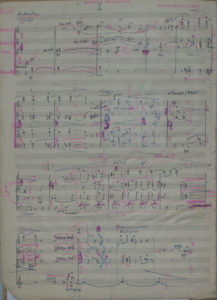- String Quartet no. 6, PWM score, mov. 1
- String Quartet no. 6, PWM score, mov. 2
- String Quartet no. 6, PWM score, mov. 3
- String Quartet no. 6, PWM score, mov. 4
String Quartet No. 6 performed by the Parrenin Quartet on 19 September 1960 at the Warsaw Autumn Festival caused a sensation. It became evident that the composer, without completely breaking the rules she had always followed in her work, had clearly modernised her sound language. Asked by Jerzy Hordyński [Życie Literackie of 16 October 1960] about how Quartet No. 6 differed from her previous works, Bacewicz responded:
It is a turn in my oeuvre. It took me a long time to write it, about nine months. I turn in this quartet to serial music in order to abandon tonality, which has marked my music. In any case, the journey to the quartet has been an evolution, through Quartet No. 5 and Music for Strings, Trumpets and Percussion.
Thus we have here an evolution the essence of which is not only the serial technique – used only in fragments in any case. This was emphasised by Tadeusz Zieliński, who wrote in an article [Spotkania z muzyką współczesną, Kraków 1975]:
Quartet No. 6 is distinguished particularly by its wealth of colours. The composer’s has come a long way since the style of Quartet No. 3, the essential elements of which were above all the line and the structure; here we have an additional, no less important element – sound, on a scale not seen in her oeuvre before.
The work consists of four movements. Andante begins with a sophisticated play of four instruments: criss-crossing glissandos of the first and second violins are heard against a delicate, flageolet background of the viola and the cello. The calm of the initial bars is broken by strong dyads (pizzicato, marcato) of the first violin, heralding the nature of the following narrative – discontinuous, consisting of short images, often pointillistic in nature. Only the knowledge of the basic series makes it possible to discover its announcement at the subsequent change of tempo. The series is developed melodically to the full when the cello presents the first note (A) played energico. Successive notes are played pizzicato in the first violin, embedded in an ostinato of the second violin and chords of the other instruments. The series consists of three cells, the second of which is an imprecise, progressive repetition of the first, while the third is an imprecise repetition in an inversion.
The series or its fragments appear in various forms (prime transposed, inversion, retrograde-inversion), making up highly sophisticated textural constellations. An example is number 6 (Allegro), when a transposed, incomplete form of the prime series appears in the first and second violins, while another, also incomplete, transposed version of the inversion can be heard in the viola and the cello. The composer opted here for a repetition of notes, creating a “theme” imitated in the inversion. All these combinations do not influence the complete picture comprising fleeting scenes richly encrusted with changing articulation, interweaving passages, mini-glissandos, pointillistically scattered short motifs.
The lack of a quasi-serial structuring of the sound material in the successive movements does not create a major contrast between the initial Andante and the other links in the cycle. The second movement (Vivace), comparable to a scherzo owing to the ending resembling the initial fragment, is, in fact, a series of textural variations with constantly changing sound shapes, overlapping of various figures, for example short passages and tremolos, and unevenly repeated chords. At some point we hear an element characteristic of the composer and found in her other works: progressive descending, monorhythmic semiquaver figures (no. 8) in the first violin. In this case they are presented against a background of also semiquaver figures of the other instruments, all of which constitutes a cluster mass. To provide contrast, the picture changes into rhythmic figures played saltando (comme percussione).
The fast movements are separated by a short Grave in which the only melodic instruments is, for a while, the cello. Only towards the end is the melodic thread taken up by the first violin, the viola and – briefly – the second violin.
The fourth movement is in the form of a rondo in which the refrain is built of a series of funny passages played stacatto and constantly changing their direction. Individual notes from largely parallel passages turn into dyads and the whole is spiced up by the fact that convergent movement turns into divergent movement at times. The second and last free episode (no. 10, meno mosso) is marked by a melody in the first violin with a very narrow ambitus, although beginning with a leap by a sixth up, accompanied by chords of the other instruments played con legno. The fragment, ending with a short imitation and a rhythmically uniform phrase, seemingly broken off, is followed by a variation-based refrain.
Bacewicz’s String Quartet No. 6 set off various reactions after the premiere, as the composer wrote in a letter to her brother Vytautas. Older listeners, headed by Professor Sikorski, accused the composer of betraying the old ideals. Younger members of the audience concluded that the piece was not radical enough. These now historical controversies testify to how “hot” the first Warsaw Autumns were, how important a role was played by the festival in each composer finding his or her own creative path.
- String Quartet no. 6, manuscript (Music Department, Warsaw University Library), title page
- String Quartet no. 6, manuscript (Music Department, Warsaw University Library), p. 1
- String Quartet no. 6, manuscript (Music Department, Warsaw University Library), p. 2






